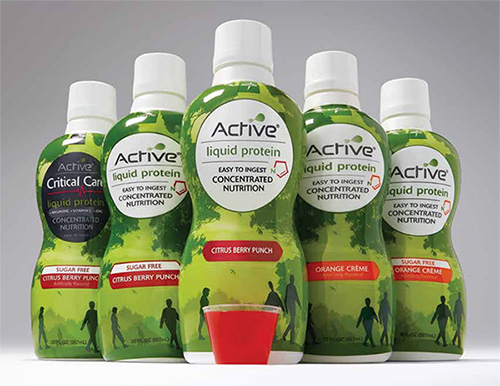Enhance nutrition, one ounce at a time.
When diet alone is not enough, our Active Liquid Protein with high protein content helps residents and patients get back to being themselves.
Adequate protein intake plays an important role in improving
many conditions commonly found in the elderly. Protein deficiency contributes to:
- Increased skin fragility1
- Decreased immune function1
- Poorer healing1
- Longer recuperation from illness in older adults.1

Patients who test for poor nutrition when they are admitted to the ICU may benefit most significantly from greater protein and energy intake, especially during longer ICU stays.2
Inadequate protein intake can also adversely affect wound healing:
- Protein deficiency has been shown to contribute to poor wound healing rates with reduced collagen formation and can result in wounds rupturing along the surgical incision.3
- High wound exudate loss can result in a deficit of as much as 100 grams of protein in one day. This subsequently needs to be replaced with a high protein diet.3
A small amount packs a powerful punch
Medline Active Liquid Protein consists of a dual protein source of hydrolyzed collagen and whey protein. A 1-oz. serving of Active Liquid Protein contains 15 to 21 grams of protein, roughly one third of the FDA suggested daily value.4
Easy to take
Because Active Liquid Protein is in liquid form, there’s no need for mixing. It’s easy to add Active Liquid Protein to hot or cold food or beverages, or to administer it orally or via feeding tube.
Looking for More Options? Explore Other Active Liquid Protein Products
| Flavor/ size | Citrus Berry Sugar, 30- oz. | Citrus Berry Sugar-Free, 30-oz. | Citrus Berry Sugar-Free, 1-oz. unit dose | Orange Crème Sugar, 30-oz. | Orange Crème Sugar-Free, 30-oz. | Mild Citrus Sugar-Free, 1-oz. unit dose |
|---|---|---|---|---|---|---|
| Protein per 1oz. serving | 15g | 16g | 16g | 15g | 16g | 16g |
| Packaging | 4/cs | 4/cs | 100/cs | 4/cs | 4/cs | 100/cs |
| Item No. | ENT693CB | ENT693SFCB | ENT693SFCBUD | ENT693OC | ENT693SFOC | ENT693SFUD |
Explore other Active products.
References:
- Chernoff R. Protein and older adults. Journal of the American College of Nutrition. 2004;23(6 Suppl):627S-630S. Available at: https://www.ncbi.nlm.nih.gov/pubmed/15640517. Accessed November 6, 2017.
- Compher C, Chittams J, Sammarco T, Nicolo M, Heyland DK. Greater protein and energy intake may be associated with improved mortality in higher risk critically ill patients: a multicenter, multinational observational study. Critical Care Medicine. 2017;45(2):156-163. Available at: https://www.ncbi.nlm.nih.gov/m/pubmed/28098623/. Accessed November 1, 2017.
- Russell L. The importance of patients’ nutritional status in wound healing. British Journal of Nursing. 2001; 10(6
Suppl):S42,S44-49. Available at: https://www.ncbi.nlm.nih.gov/pubmed/12070399. Accessed November 6, 2017. - Protein. Food and Drug Administration (FDA) website. Available at: https://www.accessdata.fda.gov/scripts/InteractiveNutritionFactsLabel/protein.html. Accessed November 6, 2017.


